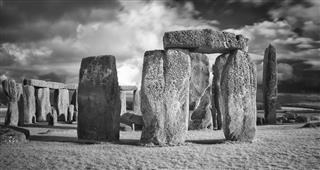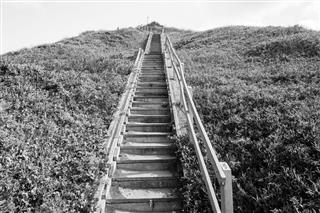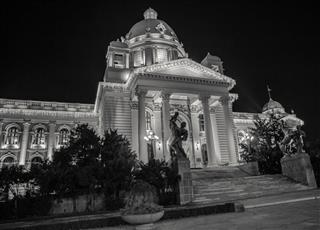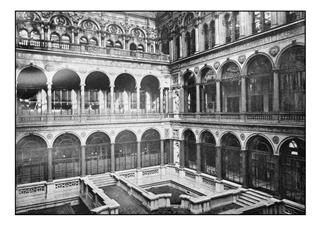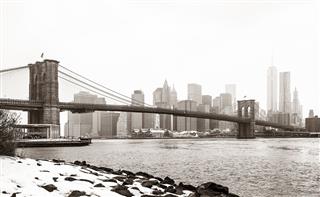
Although the field of photography has seen the growth of different technologies with time, there are certain artists who prefer black and white photography even today.
Photography was invented in the black and white form itself. As the technology advanced, color photography came into existence. Though color films are cheaply available now, some art lovers and portrait photographers still prefer black and white photography or even a black and white film, for that matter. This type of photography is popular because of its low cost and the ‘classic look’ of the photographs.
One special quality which black and white photography possesses is its unique depth, which includes the quality of giving an aesthetic value to the light and shadows. Hence, its popularity started growing among the photographers who wanted to tell a story through surrealism. There are several famous photographers who have dedicated their lives solely to this beautiful form of photography. Let’s get to know a few of them.
Arno Minkkinen (1945 – )
“What happens inside your mind can happen inside a camera.”
He is a Finnish photographer who is currently working in the United States. After completing Master of Fine Arts degree, he became a professor. Now, he teaches at the University of Massachusetts, Lowell. He is the co-founder of the ‘Spirit Level’ workshops, held around the world since the year 1996. His works can be seen in more than 50 famous art museums all over the world, including the Museum of Fine Arts, Boston.
Being a student of design, he is best known for his black and white photographs, containing the bodies in juxtaposition alongside beautiful landscaping. He plays with light and darkness, light and shadow, and also with settings and his subjects, which result in surreal and abstract pictures which are timeless. Keith Davis (the curator of Nelson-Atkins Museum of Art) writes, “As a whole, Minkkinen’s work represents a deeply personal dialogue with nature, an artistic meditation on the tensions between seeing and dreaming, union and alienation”.
Minkkinen has a unique quality of coming up with bizarre concepts of surrealism as well as balance, and equating his foreground and background. Through some of his works, he awed art lovers with a simple background, and an abstract but out of focus foreground. Minkkinen also incorporated female nudity in some of his abstract concepts. He does most of his photo shoots in the countryside and towns of the United States and his hometown, Finland. Some of his surreal black and white photographs are also shot in European cities.
Arno Minkkinen’s famous works of abstraction are Fosters Pond, White Sands, Sandy and Self-portrait, Beach Pond, CT, 1974, to name a few. He did a series of photo shoot naming his work Wasteland Illusion wherein he used a male nude body as a foreground and juxtaposed with simple landscape in the background and created an illusion. His use of double exposure made these pictures even more surreal.
James Nachtwey (1948 – )
“I have been a witness, and these pictures are my testimony. The events I have recorded should not be forgotten and must not be repeated.”
He is an American who is well-known for his war photography. He has been honored with the record number of 5 awards, including the ‘Robert Capa Gold Medal’ by the Overseas Press Club of America. He is also famous for his film on photography and photojournalism. He got wounded while taking pictures, during the year 2003, in Baghdad. He has captured many major events around the world with his camera, such as the 9/11 attacks on WTC, the tsunami in 2004, the Sudan conflict, the US invasion of Iraq and many more.
He is also known for covering and documenting tuberculosis and how it has taken its toll across countries like Cambodia, South Africa, Switzerland and Thailand. Nachtwey is popular for his sensitive documentation on certain subjects; he feels for those causes quite strongly, which speaks through his photography. Therefore, he is extremely graphic in his pictures. He uses striking contrasts in his black and white images which is very much relevant to the sensitive subjects he caters to.
Diane Arbus (1923 – 1971)
“I really believe there are things nobody would see if I didn’t photograph them.”
Besides being a photographer, Diane Arbus was also a writer. Diane Arbus was known for her square, black and white pictures. She chose eccentrics, transsexuals, transvestites, Siamese twins, sex workers, dwarfs, deformed people, and other people who were considered ‘ugly’ by the traditional norms of our society as her subjects. She also did a few fashion photography for Vogue, but quit commercial photography in 1956 and solely concentrated on her subjects of outcasts in the society.
She changed her Nikon 35mm camera and started using a twin reflex Rolleiflex to get more square pictures, which was her specialty. Arbus was known to create a bold familiarity between illusion and reality vs. behind the stage. She used very dramatic lights on her portraits, and one such example of dramatic and other light effects can be the portrait of a transvestite with heavy makeup. She took that picture with a lot of details. The dramatic light on his face enhances his ‘nothing to hide’, transparent expression. Due to the way, her camera was placed, one could also spot the wrinkles on the subject’s skin. Among all the bold subjects, her famous works are Child with a Toy Hand Grenade in Central Park, Identical Twins, A Naked Man being a Woman and Triplets in their Bedroom.
Arbus had severe episodes of depression, and was also known to have extreme mood swings. In the year 1971, she was found dead in her bathtub due to an overdose of barbiturates, which she injected herself to end her life.
Robert Capa (1913 – 1954)
“If your pictures aren’t good enough, you aren’t close enough.”
Born in Budapest, Robert Capa was a 20th century photojournalist. He was mostly famous as a combat photographer, as he covered as many as five wars, namely, the Spanish Civil War, the Sino-Japanese War II, World War II, Arab-Israeli War in 1948, and Indochina War I. He always emphasized on catching real life moments, rather than studying about the technical details.
Capa was the co-founder of Magnum Photos, along with Henri Cartier-Bresson. Capa was famous for his leftist reflection in his works. He prided himself in capturing men, women and children in the middle of crises, especially wars and conflicts. He is famous for his photo essay, Capturing the Truth.
He met with a sad end at the age of 40, while covering the first Indochina War, when he stepped on a land mine.
Henri Cartier-Bresson (1908 – 2004)
“The photograph itself doesn’t interest me. I want only to capture a minute part of reality.”
Supposedly the father of the modern photojournalism, Henri Cartier-Bresson was a French journalist. He made a major contribution in the ‘real life reportage’ or ‘candid photography’, which is still very popular among professional and amateur photographers. He is one of the revolutionary photographers to have adopted the 35mm rangefinder cameras.
In his lifetime, Cartier-Bresson witnessed the Spanish Civil War, the Liberation of Paris, the fall of Kuomintang in China and many historical moments. He was inspired by the famous Hungarian surrealist photojournalist, Martin Munkácsi. Basically, Cartier-Bresson’s shift from a painter to a photographer was because of the surreal uprising in paintings, literature, and films. He was an ardent traveler and went around with his camera so as to shoot anything interesting that might come his way; he was the pioneer behind the concept of ‘street photography’. He passed away at the age of 95.
Some of his works are Behind the Gare Saint-Lazare, Cell in a Model Prison in the U.S.A., and Roman Amphitheater.
Ansel Adams (1902 – 1984)
“There are no rules for good photographs, there are only good photographs.”
We simply cannot miss out this prestigious name when talking about famous black and white photographers. This American-born photographer was also a well-known environmentalist, revered till date. He, along with Fred Archer, formulated the now world famous ‘Zone System’, that enhances the quality of pictures. He also founded the ‘Group f/64’, a group of seven photographers with the same kind of photographing style. Their collection is exhibited in the photography department of Museum of Modern Art, New York, even today.
Adams’ timeless photographs could be seen in books, calendars, and posters. He was known for breaking all the rules in photography. Nowadays, when taking a photograph is made extremely convenient to us with highly efficient DSLR cameras and professional photo editing software, Adams came up with the concept of the ‘rule of thirds’ which is religiously followed by all professional photographer as well as paleographers.
Being a classical pianist and an environmentalist, he showcased a panoramic view of humanistic nature in almost all his photographs, be it a portrait or landscape picture. Winter Storm is one of his famous works. One look at that picture and the viewer can feel the panoramic effect along with the feel of the stormy wind as if it is playing some tunes while passing through the mountains, over the fig trees. His other famous photographs include Monolith, The Face of Half Dome, Ice on Ellery Lake, Sierra Nevada and many more.
Dorothea Lange (1895 – 1965)
“Photography takes an instant out of time, altering time by holding it still.”
Dorothea Lange was an influential American photojournalist. Known for her interests in humanistic emotions, her work surrounds and captures the time frame of the World War II. Lange documented the ethnic groups and their sufferance due to the change of home fronts, displaced families, forced reallocation of families, and workers during the Great Depression.
She won the prestigious award, ‘Guggenheim Fellowship’ for her work, Migrant Mother. Shot during the tragic chain of events during the World War II, this photograph is a captured image of a woman with her kids in a camp who must have been relocated by force. Her expressions are a mix of sadness, confusion, helplessness, and anxiety. The natural light which falls on her face makes the expressions more transparent. She created a juxtaposition between human emotions and physical reality.
Lange faced certain censorship issues from the U.S. Federal Government while capturing the photographs of the forced evacuation of the American-Japanese to camps after the Pearl Harbor attack. She died due to cancer in 1965. Some of her renowned works are, Refugee Camp Near Holtville, The White Angel Bread Line in San Francisco, and Japanese Boy Awaiting Evacuation.
Jacques Henri Lartigue (1894 – 1986)
“Photography to me is catching a moment which is passing, and which is true.”
He was a famous French photographer and a renowned painter. He started photography as a hobby at the age of six, capturing his own life and the people involved in it, on camera. He is mostly famous for automobile racing photographs. Most of his earlier photographs were taken in the ‘stereo’ format, but later he explored almost all the modern-day photography techniques. His 120 photograph albums are his best visual autobiography. Lartigue photographed several sporting events as well, including the French Open,French Grand Prix and Coupe Gordon Bennett of auto racing.
He believed in ‘cropped images’ wherein the images are resized to get better impact and resolution. The veteran photographer died in the year 1986.
The list doesn’t end here. There are many more renowned photographers who have lived their lives for this definitive art. Only a true art lover could admire the treasures of black and white photography. What’s your opinion on this?










